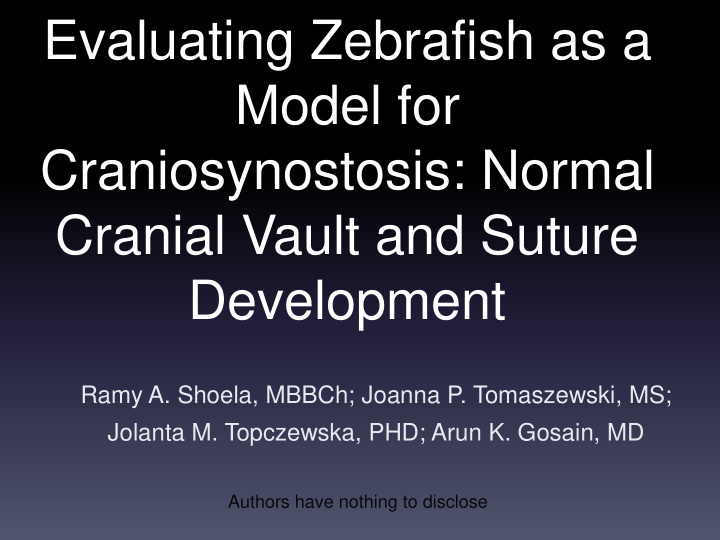



Evaluating Zebrafish as a Model for Craniosynostosis: Normal Cranial Vault and Suture Development Ramy A. Shoela, MBBCh; Joanna P. Tomaszewski, MS; Jolanta M. Topczewska, PHD; Arun K. Gosain, MD Authors have nothing to disclose
Introduction Zebrafish is a fresh water vertebrate well-established for studying developmental biology. • Zebrafish was adopted to study pathophysiological processes and treatment modalities: – cardiomyopathy – musculoskeletal disorders – defective metabolic pathways – cancers • The rapidly evolving gene editing technologies for the zebrafish genome encourages its use as a disease model.
Objectives • To evaluate the use of the zebrafish model to study craniosynostosis • To characterize normal development of zebrafish cranial bones and sutures
Similar cranial vault frameworks exist between zebrafish and higher vertebrates F=frontal. P=parietal. OC=occipital IP=interparietal. SO=supraoccipital. N=nasal Schematic representation (dorsal view) of the human cranium (left), the mouse cranium (middle) and the zebrafish cranium (right)
Material and Methods • The developmental stage of the zebrafish was identified by its standard length (SL), the distance from the snout to the caudal peduncle. • Zebrafish bones and cartilages were stained with alizarin red and alcian blue, respectively. The cranial vault was dissected under a stereomicroscope and mounted for imaging and analysis. Eighty five fish were used for our analysis.
• The projected area of each cranial vault bone and suture was measured. • Frontal (F), parietal (P), and supraoccipital (SO) bone areas were measured. • The interfrontal sutural area was measured as the area of overlap between two frontal bones. Parietal suture was measured as the overlap between the two parietal bones and the coronal suture as the area of the parietals overlapped by the frontals.
Features of the Developing Zebrafish Cranial Vault • Dorsal views of the developing cranial vault bones of fish with standard lengths between 6.5 and 13.1 mm (interval 0.5 – 1 mm) Figures A-H. • In early development, bone ossification replaces the intervening mesenchymal tissue. The cranial vault then continues to grow while the intervening sutural tissue maintains the interaction between the overlapping bones as shown in Figure I fish (26 mm SL)
Pattern of Early Bone Ossification Frontal bone ossification progresses medially in a fan like manner while the parietal bone grows as circumferential rings. Pattern of bone growth was determined using overnight staining with alizarin red (7.7 mm SL) followed by four interval. The sample was then incubated overnight in calcein green stain overnight (8.1 mm SL) and washed for 3 days. It was finally incubated in alizarin red overnight (8.6 SL), washed and euthanized. The skull was then dissected and examined under a fluorescence microscope.
Calvarial Bone Growth Correlates Linearly with SL 4.5 y = 0.1455x - 0.9524 R² = 0.98674 4 Projected Surface area of bone mm^2 3.5 3 y = 0.0902x - 0.6487 2.5 R² = 0.9768 2 y = 0.0432x - 0.2554 1.5 R² = 0.9804 1 0.5 0 5 10 15 20 25 30 35 40 Standard Length mm • Cranial bones growth maintains a linear relationship with increasing zebrafish SL • Most rapid surface area increase occurs in the frontal bone, followed by the parietal and supraoccipital bones
Sutural Overlap Growth Correlates Linearly with SL 0.7 y = 0.0258x - 0.2564 R² = 0.7402 0.6 sutural overlap projected area mm^2 0.5 0.4 y = 0.0112x - 0.0938 0.3 R² = 0.4886 0.2 y = 0.0054x - 0.0531 R² = 0.4108 0.1 0 10 15 20 25 30 35 40 Standard Length mm • Suture progression shows a linear relation to standard length • Area of overlap between the frontal and parietal bone at the coronal suture progresses more rapidly than the midline sutures
Histologic Features of Zebrafish Cranial Sutures A. Transverse section through zebrafish skull (5x), pentachrome stain. B and C. Interfrontal suture showing frontal overlap and frontal interlocking respectively (40x), pentachrome and H&E stain. D. Sagittal section through zebrafish (5x), H&E stain. E and F. Coronal suture showing frontal overlap parietal and slight interlocking respectively.(40x), H&E stain.
Conclusion • Zebrafish cranial vault consists of paired frontal bones, paired parietal bones and unpaired supraoccipital bone, showing a high level of homology to higher vertebrates. • Cranial vault bone growth linearly correlates with increasing SL in developing zebrafish. Each bone, however, demonstrates unique growth dynamics. • Sutural histology of zebrafish resembles mouse sutures. In contrast to mice, in which posterior interfrontal sutures fuse by day 28, zebrafish cranial sutures remain patent throughout life. In humans, the metopic suture fuses in the first year of life.
Significance of Results We established the normal growth patterns of the cranial vault bones and sutures, which can be used as references to identify abnormal development in mutant strains and transgenic lines. We also developed various experimental techniques to analyze zebrafish cranial vault development that could be used for further studies.
Acknowledgements • Elizabeth E. LeClair, Ph.D. • Michael Gart, M.D. • Tatiana Favelevic • Yen-Yen Gee
Recommend
More recommend